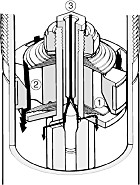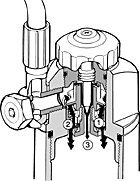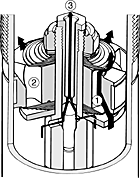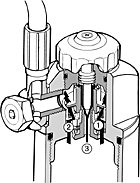|
|
Compression Stroke
|

1. The oil
flow in the shock absorber body andů |
During a compression
stroke path 1, fig 1, is closed, and the oil can only
flow through the paths 2 and 3. The damping forces at
a certain compression speed are determined by the flow restrictions
in these paths.
The flow restriction through path 2, fig 1, is determined
by how much the oil pressure can open the compression shims
which are shut close whenever the pressure is too low or the
shock is not moving in a compression mode. These shims resistance
to opening are decided by their numbers, thickness' and diameters
and are carefully chosen to give the best setup. |

2. In the
reservoir during a compression stroke. |
Path 3, fig
1, is the main bleed valve. The larger orifice, the less
oil flows through path 2 making the main valve compression
forces lower.
Oil displaced by the piston shaft is forced into the reservoir.
At low poston velocities this flow is regulatedby the reservoir
compression bleed valve, path 3, fig 2. At higher by
shim stack, path 1 and 2, in parallel with the bleed
valve. |
Rebound Stroke
|

4. In the
shock absorber body during a rebound stroke. |
During a rebound stroke the
oil flows the opposite way. Path 2, fig 3, is closed
and oil can only pass through paths 1 and 3.
The flow restriction through path 1 is determined by
the rebound shims and the flow through path 3, the main
bleed valve. To compensate for the displacement of the shaft
a check valve in the reservoir, path 1 and 2, fig 4,
opens and the oil returns to the shock body. |

4. The oil
flow in the reservoir and... |
|
External Adjusters
|
The Íhlins LMJ
shock absorbers have the low speed compression adjustment knob
located on top of the reservoir. The low speed rebound adjuster
is located, easy to reach, at the lower end of the piston shaft.
Both the adjusters have a normal right-hand thread. Click position
zero (0) is when the adjusters are turned clockwise to fully
closed, and then opened to the first click.
Making adjustments
Suspension settings are dependent on your car's weight, your
driving style, track conditions etc. If you are not happy with
our recommended settings, here are a few guidelines and ground
rules how to make adjustments.
To make improvements, it is important to understand the function
of the shock absorbers and through testing learn how they affect
the handling of your car.
When making adjustments, always start with the Íhlins recommended
settings. Keep notes, make adjustments one at a time... and
in small steps.
The adjusters should normally not be adjusted in steps of more
than 2 clicks at a time and not outside the usable click range.
When you think you have made an improvement, go back to what
you started with and double check to be sure. Pay attention
to changes in conditions like tires, temperatures, etc.
In general, compression damping changes should be used to influence
the car's stability and response, while rebound damping changes
should be used to influence comfort and traction.
When you need more damping force, you should mainly try to increase
compression damping and use as little rebound damping as possible.
This usually means that you gain comfort and handling performance. |
|